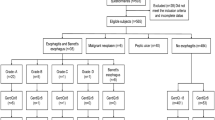Abstract
The techniques used in the diagnosis of gastroesophageal reflux disease (GERD) have insufficient specificity and sensitivity in diagnosing laryngopharyngeal reflux (LPR). The purpose of this study was to evaluate the role of esophagogastroduodenoscopy (EGD) and laryngological examination in the diagnosis of LPR. A total of 684 diagnosed GERD and suspected LPR patients were prospectively scored by the reflux finding score (RFS) which was suggested by Koufman. A total of 484 patients with GERD who had RFS ≥7 were accepted as having LPR. 248 patients with GERD plus LPR on whom an endoscopic examination was performed were evaluated. As a control group, results from 82 patients with GERD who had RFS <7 were available for comparison. The GERD symptom score (RSS) was counted according to the existence of symptoms (heartburn/regurgitation) and frequency, duration, and severity. The reflux symptom index (RSI) suggested by Belafsky et al. was also evaluated. The relationship between esophageal endoscopic findings, RSS, RFS and RSI was investigated. Mean age was 46 ± 12 (19–80). The mean values of RSS, RFS, and RSI were 18.9 ± 7.7, 10 ± 2.2, 16.6 ± 11.9, respectively. Erosive esophagitis was detected in 75 cases (30%). Hiatus hernia was observed in 32 patients (13%). There was no correlation between RSS and RFS, RSI. The severity of esophagitis did not correlate with the severity of the laryngeal findings. LPR should be suspected when the history and laryngoscopy findings are suggestive of the diagnosis. EGD has no role in the diagnosis of LPR.

Similar content being viewed by others

References
Jaspersen D, Kulig M, Labenz J, Leodolter A, Lind T, Meyer-Sabellek W, Vieth M, Willich SN, Lindner D, Stolte M, Malfertheiner P (2003) Prevalence of extra-oesophageal manifestations in gastro-oesophageal reflux disease: an analysis based on the ProGERD study. Aliment Pharmacol Ther 17:1515–1520
Koufman JA, Belafsky PC, Bach KK, Daniel E, Postma GN (2002) Prevalence of esophagitis in patients with pH-documented laryngopharyngeal reflux. Laryngoscope 112(9):1606–1609
Koufman JA (1991) The otolaryngologic manifestations of gastroesophageal reflux disease. Ambulatory esophageal pH monitoring: practical approach and clinical applications. Igakushion Med Publ Inc. New York, 129–149
Groome M, Cotton JP, Borland M, McLeod S, Johnston DA, Dillon JF (2007) Prevalence of laryngopharyngeal reflux in a population with gastroesophageal reflux. Laryngoscope 117(8):1424–1428
Mel-S Ali (2008) Laryngopharyngeal reflux: diagnosis and treatment of a controversial disease. Curr Opin Allergy Clin Immunol 8(1):28–33 Review
Bove MJ, Rosen C (2006) Diagnosis and management of laryngopharyngeal reflux disease. Curr Opin Otolaryngol Head Neck Surg 14(3):116–123 Review
Akyildiz S, Varis A, Vardar R, Bayrakci B, Kirazli T, Bor S (2009) Impact of different pH cut-off values on patients with laryngopharyngeal reflux disease. Gut 58((Suppl II)):A436 Abstract: P1648
Noordzij JP, Khidr A, Desper E, Meek RB, Reibel JF, Levine PA (2002) Correlation of pH probe-measured laryngopharyngeal reflux with symptoms and signs of reflux laryngitis. Laryngoscope 112(12):2192–2195
Belafsky PC, Postma GN, Koufman JA (2001) The validity and reliability of the reflux finding score (RFS). Laryngoscope 111(8):1313–1317
Tauber S, Gross M, Issing WJ (2002) Association of laryngopharyngeal symptoms with gastroesophageal reflux disease. Laryngoscope 112:879–886
Lund ell L, Dent J, Bennett J et al (1999) Endoscopic assessment of esophagitis: clinical and functional correlates and further validation of Los Angeles classification. Gut 45:172–180
Locke G, Galley N, Weaver A, Zinsmeister A (1994) A new questionnaire for gastroesophageal reflux disease. Mayo Clin Proc 69:539–547
Kitapcioglu G, Mandiracioglu A, Bor S (2004) Psychometric and methodological characteristics of a culturally adjusted gastroesophageal reflux disease questionnaire. Dis Esophagus 17:228–234
Tauber S, Gross M, Issing WJ (2002) Association of laryngopharyngeal symptoms with gastroesophageal reflux disease. Laryngoscope 112:879–886
Vakil N, Veldhuyzen van Zanten S, Kahrilas P, Dent J, Jones R (2006) The Montreal definition and classification of gastroesophageal reflux disease (GERD): a global evidence-based consensus. Am J Gastroenterol 101:1900–1920
Koufman JA (1991) The otolaryngologic manifestations of gastroesophageal reflux disease (GERD): a clinical investigation of 225 patients using ambulatory 24 hour pH monitoring and an experimental investigation of the role of acid and pepsin in the development of laryngeal injury. Laryngoscope. 101(4 Pt 2 Suppl 53):1–78 Review
Bor S, Vardar R, Vardar E, Takmaz S, Mungan AZ (2008) Endoscopic Findings of Gastroesophageal Reflux Disease in Turkey: Multicenter Prospective Study (Görhen). Gastroenterology 134(5 suppl 1):T2014 (600)
Jonaitis L, pribuisiene R, Kupcnskas L, Uloza V (2006) Laryngeal examination is superior to endoscopy in the diagnosis of the laryngopharyngeal form of gastroesophageal reflux disease. Scandinavian J of Gastroenterol 41:131–137
Richter JE (1997) Ambulatory esophageal pH monitoring. Am J Med 103:130S–134S
Lai Y-C, Wang P-C, Lin J-C (2008) Laryngopharyngeal reflux in patients with reflux esophagitis. World J Gastroenterol 14(28):4523–4528
Knight RE, Wells JR, Parrish RS (2000) Esophageal dysmotility as an ımportant co-factor in extraesophageal manifestations of gastroesophageal reflux. Laryngoscope 110:1462–1466
Poelmans J, Feenstra L, Demedts I, Rutgeerts P, Tack J (2004) The yield of upper gastrointestinal endoscopy in patients with suspected reflux-related chronic ear, nose, and throat symptoms. Am J Gastroenterol 99(8):1419–1426
Jaspersen D, Kulig M, Labenz J, Leodolter A, Lind T, Meyer-Sabellek W, Vieth M, Willich SN, Lindner D, Stolte M, Malfertheiner P (2003) Prevalence of extra-oesophageal manifestations in gastro-oesophageal reflux disease: an analysis based on the ProGERD Study. Aliment Pharmacol Ther 17:1515–1520
Vaezi MF, Richter JE, Stasney CR, Spiegel JR, Iannuzzi RA, Crawley JA, Hwang C, Sostek MB, Shaker R (2006) Treatment of chronic posterior laryngitis with esomeprazole. Laryngoscope 116:254–260
Conflict of ınterest
None.
Author information
Authors and Affiliations
Corresponding author
Rights and permissions
About this article
Cite this article
Vardar, R., Varis, A., Bayrakci, B. et al. Relationship between history, laryngoscopy and esophagogastroduodenoscopy for diagnosis of laryngopharyngeal reflux in patients with typical GERD. Eur Arch Otorhinolaryngol 269, 187–191 (2012). https://doi.org/10.1007/s00405-011-1748-y
Received:
Accepted:
Published:
Issue Date:
DOI: https://doi.org/10.1007/s00405-011-1748-y



